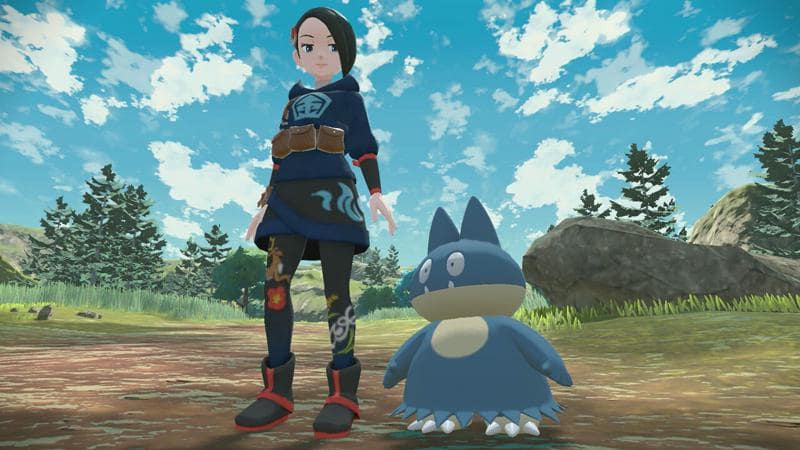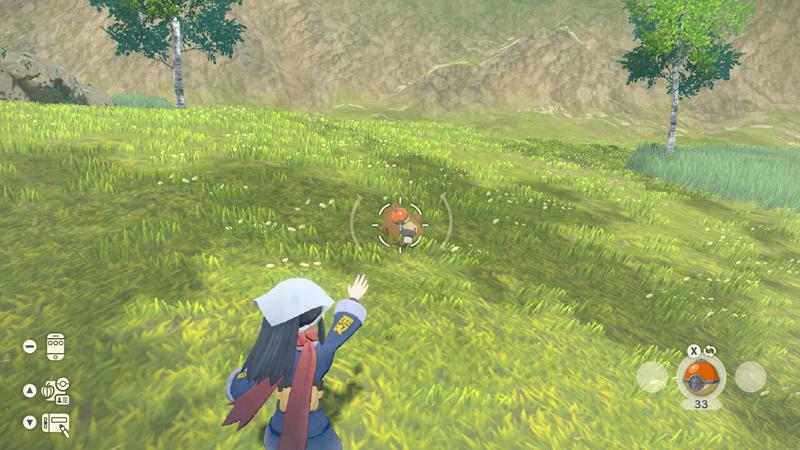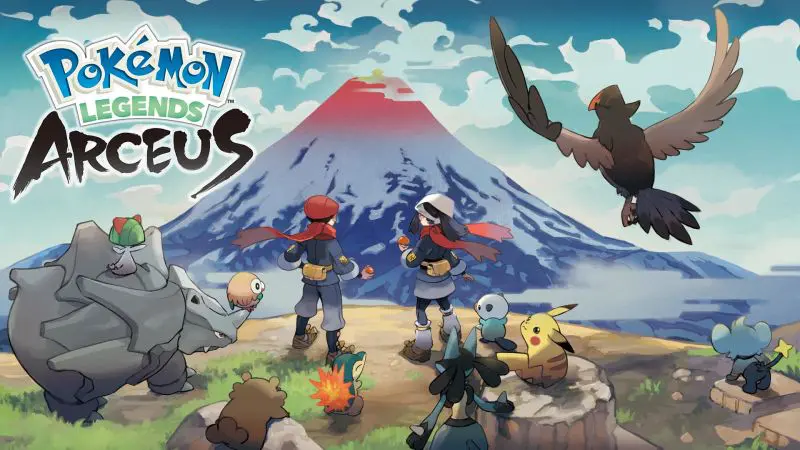Mainline Pokemon games have always managed to achieve a degree of competency. The general trend has been one of decline, even if subsequent games have made improvements in certain areas, the fan-fueled criticism of incessant handholding, lacking difficulty and seemingly the inability to move with the hardware has made later entries in the franchise weaker versions of what came before them. I go back every year and play one from the GBA or DS, and while nostalgia still has its deep pincers in me, I still believe they’re far more well rounded than Game Freak’s more recent efforts.
This consensus culminated in Pokemon Sword/Shield, the first true Nintendo Switch Pokemon which played like one still stuck on the 3DS, imbued with even more corporate blunders pertaining to the series’ misled belief they need to be dumbed down even further. They were fine, enjoyable at times, even if the level of difficulty was borderline offensive and the visuals screamed “rush job”, but it was clear Pokemon was in a sorry state, and the power of the Switch wasn’t being used properly.
With the degree of texture popin found in Pokemon Legends: Arceus, you’d think that sentiment would ring true again, yet finally, with a complete shakeup of the series’ formula comes an instalment which wins twofold, bringing mainline Pokemon into modern times with a highly derivative yet equally respectable sense of style, and also finally leaping over some of the series’ most devastating pitfalls. While not a complete triumph, stumbling over narrative tropes and a false sense of depth, Pokemon Legends: Arceus is a game I can see someone lauding as the best in the series, and it deviates so much from what Game Freak have been doing for the past few decades that it can actually draw in an audience which once might’ve had no interest in Pokemon.
Top-to-bottom Arceus screams Breath of the Wild. It did in the trailers which did more to dissuade a purchase than it did encourage one, and it does in the final product too. Does it play like Link’s latest adventure? Not at all, but tonally, delineated through its visuals and sound design, it’s clear where the inspiration lays. The terse pops of a successful Pokemon capture, the subdued and often absent score, the bright and blooming foliage, interspliced with objects symbolising nascent or withered civilisation. All of it, I would go as far to say, is aping Breath of the Wild. The obvious counterpoint to this is that Breath of the Wild is one of the most splendid video games of the last decade, and an imitation can only be positive at the end of the day. Draw distance withstanding, yes, yes it is. Arceus, released mere months after the rather hideous looking remakes of Diamond & Pearl, is a Nintendo Switch game through and through, technical limitations and all, and emphasis on the “Nintendo ” given the inspiration. More poignantly Arceus, unlike the few games which preceded it (excluding Pokemon Snap) has joined the current generation with well rendered textures, completely passable animations and an overall experience which never plays poorly, buggy or implies a cheap development cycle.

I want to get the comparison chatter out the way immediately because I think in the larger scale of the game, it’s insignificant, even if you are of the belief it’s an ill-fitting copy, it’s a nice one at that which borrows almost nothing in its gameplay. It’s gameplay also diverges sharply away from what has made a mainline Pokemon game in the past, to a degree you have to question whether Arceus even is a mainline release. Battling is still here, and in typical Pokemon fashion, most advancements or tweaks – good and bad – have been thrown in the Trubbish or altered in a way which feels distant from what it originally was. For one, battling is no longer the focus. Becoming the best trainer in the land – which this time is Hisui, Sinnoh before Sinnoh existed – is no longer a viable career path. We are instead a time traveller of sorts, sent back to the area’s incipience by Arceus himself. Armed with the knowledge of a Pokemon player, we enter the Survey Corps, a group set up to charter and examine Pokemon, a band of monsters we as players adore, but they as in-universe ancestors fear and woefully misunderstand. Gyms are gone, and while battles remain, they do so in a diminished form: trainer battles are sparsely integrated, and random encounters have been gutted in favour of upfront and clear opportunities to fight a wild Pokemon. Instead, perhaps in ode to franchise mascot Ash Ketchum, we’re tasked with catching ‘em all and completing the Pokedex, a task which has evidently never been accomplished in this time period.
And by Sinnoh I love this angle! For so long, it feels like the heart of Pokemon has been missing, intentionally thrown to the side in favour of shoddy children’s narratives and half-assed setpieces, the “heart” of course being the Pokemon themselves. Ash’s escapades, itself a reimagining of the player’s mission in Pokemon Red/Blue, is what I’ve liked best about Pokemon since its inception. The combat has always been a (the?) stalwart gateway into JRPG’s, but the creature design is what separates it from franchises of all genres. Catching them all has always been an irritating fight against corporate greed as simultaneous releases lock Pokemon away to specific versions, forcing the purchase of the same game twice or fruitless trading, but the journey has always been worth going on anyway, especially given how consistent the calibre of Pokemon designs have been. With Arceus, a rare entry with no brotherly counterpart, every Pokemon in the game can be found and documented without selling your soul to The Pokemon Company, nor requiring the social energy for trading, making my infinite Gengar dream a reality.
Arceus’ core gameplay loop is one of observing a Pokemon through several arbitrary means to complete their Pokedex entry. Gone is the technological backbone of the Pokedex we’ve come to know; paper and pencil are out capturing tools, and prior to a Pokemon’s discovery, their entries are entirely missing. Starting in a sunny fieldland, we’re guided swiftly through the new way of playing Pokemon. Pokemon are attributed aggression levels: here Bidoof is a laid back dude, observing you just as much as you observe him up close, Starly flies close to its skittish real world counterpart and flees at the sight of you, and Shinx’s playful cat persona converts into outright aggression once you’re spotted. All Pokemon fit into these three camps to certain intensities, some blending the two at times like Chansey who is generally passive but fears quickly if sensing potential provocation. It’s a good thing they do slot into just three styles because akin to every other Pokemon game, there’s a fair few to encounter, and being able to quickly establish whether or not they want a scrap or not is a useful tool when it comes to padding out their Pokedex entries.
Each entry has certain criteria, and for an entry to be marked “complete” you must fulfil a certain amount of them, which for the vast majority of Pokemon is easy enough with just a few sole confrontations. Catch x amount of Pokemon is a staple across the board, while some criteria involves using a move a certain number of times, feeding a Pokemon food, scaring a Pokemon off with an item or attacking with them while in a “stance”. You can “perfect” a Pokedex entry by completing every objective, though due to the expansive and ludicrous criteria required to complete for a perfect score, you won’t want to. Using a move 40 times for example boils down to finding Pokemon you can one-shot and repeating it over and over again; a quest designed for those with no real-world responsibilities (children?). Ignoring that tertiary objective though, completing an entry the simple, reasonable way is decently fun, even if the criteria for each ‘mon is largely insignificant to their character. Some make sense – feeding Munchlax 20 times because he’s a lard arse is entirely reasonable – but others, notably the “use this move” tasks are just randomly chosen. Still, the staple aim of just lobbing a Pokeball at their face is consistent across the board and proves quite an enjoyable routine, dashing between long grass for cover, creeping behind their back to thwack them with a ball, issuing a small wobble and, hopefully, the aforementioned sizzle and pop upon a victorious hunt, an soundbite which swiftly made its way to my notification sound. It’s important you get behind them, as it increases your chance of capture significantly, as does choosing the correct ball, which does ultimately end up being a game of “use ultra ball until you’ve run out”, but is a nice balancing act early in any way.
It’s a let down then that there’s not much depth in this area. The game’s tutorial teaches us to engage in battle with aggressive Pokemon to capture them, but all three varieties can be nabbed with traditional “throw a ball at them” techniques so long as they haven’t spotted you, which with abundant tall grass and items is easily done. The majority of disappointment comes in how little variety there is in Pokemon behaviour. Chansey and their splicing between two demeanors isn’t that nuanced, nor commonplace among other Pokemon. It should be noted there is a crafting system, because of course there is, and with that system we can create lures, Pokeballs and devices to aid our hunt, but none of it is really required because all Pokemon act in the same way; an oran berry? I’ll chow down and leave my back exposed to you, oh strange human!

Sometimes the game forgets this is what Arceus is all about, though, pushing through with the tried and tested hackneyed narrative modern Pokemon games just love to indulge in. It’s very grandiose and very pointless, and to draw a comparison to Zelda again, I wish it took the non-existent urgency of Breath of the Wild and used it here, forming a game which is more like a sedate fauna observation than a dramatic world devastation event. Game Freak always falls back on this and I don’t understand why. I don’t think I can name more than a couple of characters in the Pokemon universe of late, because they all exist to be digestible to children, furthering maxims of teamwork and goodness that any child already understands. When I was a sprog, the overbearing main stories were part of what shifted me away from Pokemon, and when I got back into them on the 3DS, Pokemon Moon unrelentingly beat me back away from the franchise again with perhaps the series’ nadir in terms of handholding.
Back on topic, Arceus understandably wants to revel in Sinnoh’s origin and ancestry, but doing so in such an upfront way only hurts the game’s flow. Cutscenes, while not as egregiously long as Sun/Moon or Sword/Shield, still exist to convey little information in a bland way in too much time; a trifecta of shitty storytelling. It’s weird that the game so blatantly borrows from Breath of the Wild in its style and tone, yet feels inclined to treat the player like a child with regards to narrative convention. It’s made doubly obvious by the requests portion of the game, essentially side quests sporadically dished out from random NPC’s which serve to delve deeper into a specific Pokemon’s attributes and abilities. One early request has you track down mischievous Bidoof gnawing through Jubilife Village’s structures. They are based on a beaver after all, and humanity, understandably utterly fearful of beasts like the slimy Goodra, floating fly trap Carnivine and the 30ft tall metal worm Steelix, just don’t understand why Bidoof does what they do. You, a time traveller of sorts, explain their function as a companion, and you can visibly see their impact on the village upon the requests completion as they chop wood for the workers to build new buildings.
The key difference between the main quest and side content is that the latter imparts useful, fun commentary on humanity and Pokemon relations, and the former is just about humans with a sprinkling of information about the legendary beasts. Humans are boring, and Pokemon should be about Pokemon, without sounding as dogmatic as I can, mind. The biggest issue with the main quest is that it gets in the way. I want to discover Pokemon on my own, even ignoring the requests, finding Pokemon in their habitats is a laugh, and hearing empty platitudes on the meaning of teamwork only issues frowns from me.
It might sound like combat has been gutted this time round, but it hasn’t, it’s actually made a tangible improvement with the introduction of “stances”, variations on moves which either make them weaker or stronger for the tradeoff of increased or decreased speed. It’s still turn based, but in a way more akin to a Final Fantasy turn system where one side may be capable of letting off a handful of swift jabs before a calamity of a haymaker is thrown down from the other team. Gone are the days of selecting a move and hoping you go first. Speed is still an attribute, but it’s fluid, in a different way to status moves too. You can enter a battle wild Pokemon by tossing a Pokeball at it – back strikes work here too for a bonus free turn – and the game decides based on speed which will strike first. You then take turns choosing moves, but you can influence turn order with stances. It’s not overwhelming, attributed to the simple logic of “if I use an agile move first, I can follow up with a strong move”, but coming from traditional Pokemon, it’s a change to the formula which emphasises the game’s shift away from every game that came before it.
I did find myself yearning for more fighting, I can’t deny, even as a proponent for the new style of Pokemon, old fashioned battling never gets dull. Linked to this is the element of bonding with your Pokemon, not in the hackneyed way Game Freak have tried to push with before with Sword/Shield’s camp system or the long running affection metre, instead in a more emotional sense; catching a Pokemon you’ve never seen and using it for the entire game through strife and victory, developing a relationship to your digital pets. It’s soppy and wholeheartedly childish, but isn’t that what Pokemon should all be about (maybe less of the former, however)? It’s a symptom of Arceus’ deemphasised combat, I think, as the Pokemon you carry with you throughout your expeditions are nothing more than tools, oftentimes in a more literal sense, used to smash boulders for ore and whack trees for berries. To be clear, I’m glad Arceus is something different, and what it is is enjoyable through its distinction from the other games, but getting there meant sacrificing some of the better parts of the game that came before it.
That’s where I am in general with Pokemon Legends: Arceus. It’s a superb template, a foundation for games to come, and in that way is clearly not the paradigm of what a game like this could be. Take crafting for example, and my previous statement on it. It’s just not required, or, less than that; it feels tacked on. Crafting anything other than more Pokeballs was a non-option because the game isn’t nuanced enough. Pokemon fit into groups, and those groups are rigid, spilling over occasionally but scared to assimilate meaningfully. Its presented in a way which implies a stoicism and seriousness which the immature and tropey narrative clashes with, made more apparent by the side content which remains true to the tone it should be striving for. I enjoy Pokemon Legends: Arceus in isolation, regardless of its shortcomings, but foreseeing an evolution of this formula is where the true excitement materialises. And if Arceus ends up being a one off experiment, at the very least it proved a thoroughly enjoyable one in its own right.

